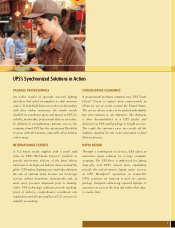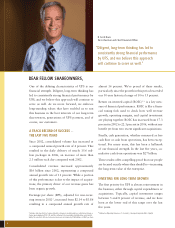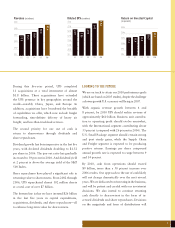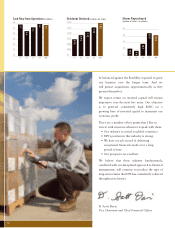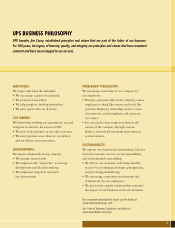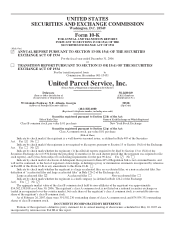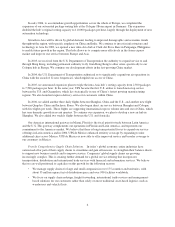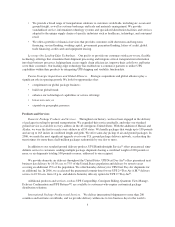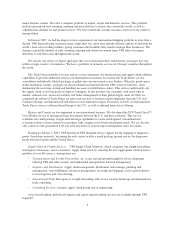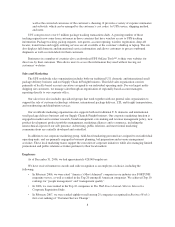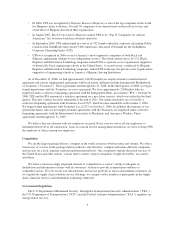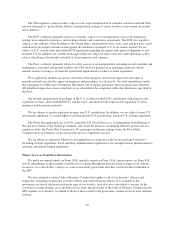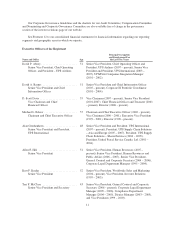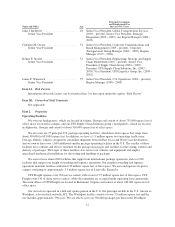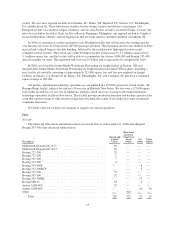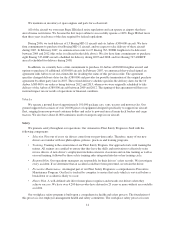UPS 2006 Annual Report Download - page 19
Download and view the complete annual report
Please find page 19 of the 2006 UPS annual report below. You can navigate through the pages in the report by either clicking on the pages listed below, or by using the keyword search tool below to find specific information within the annual report.In early 2006, to accommodate growth opportunities across the whole of Europe, we completed the
expansion of our automated package sorting hub at the Cologne / Bonn airport in Germany. The expansion
doubled the hub’s original sorting capacity to 110,000 packages per hour, largely through the deployment of new
automation technology.
Growth in Asia will be driven by global demand, leading to improved demographic and economic trends
throughout the region, with specific emphasis on China and India. We continue to invest in infrastructure and
technology in Asia. In 2002, we opened a new intra-Asia hub at Clark Air Force Base in Pampanga, Philippines
to enable future growth in the region. This hub allows us to compete more effectively in the Asian express
market and improve our service between Europe and Asia.
In 2003, we received from the U.S. Department of Transportation the authority to expand service to and
through Hong Kong, including permanent authority to fly from Hong Kong to other cities, specifically to our
Cologne hub in Europe. We continue our development efforts in the fast-growing China market.
In 2004, the U.S. Department of Transportation authorized us to significantly expand our air operations in
China with the award of 12 new frequencies, which tripled our access to China.
In 2005, we announced expansion plans to triple the intra-Asia hub’s sorting capacity from 2,500 packages
to 7,500 packages per hour. In the same year, UPS became the first U.S. airline to launch non-stop service
between the U.S. and Guangzhou, which lies strategically in one of China’s fastest growing manufacturing
regions. We also launched express delivery service for customers within China.
In 2006, we added another three daily flights between Shanghai, China and the U.S., and another new flight
between Qingdao, China and Incheon, Korea. We also began direct air service between Shanghai and Cologne
with five flights per week. Those flights are supporting international express volume into and out of China, which
has seen dramatic growth in recent quarters. To continue our expansion, we plan to develop a new air hub in
Shanghai. We also added two weekly flights between the U.S. and Australia.
Our Americas international gateway in Miami, Florida is the focal point for trade between Latin America
and the U.S. This gateway complements our operations in Florida and Latin America, and represents our
commitment to the Americas market. We believe that there is long-term potential for us to expand our service
offerings in Latin America and in 2006, UPS de Mexico enhanced territory coverage by expanding to nine
additional cities across Mexico. UPS de Mexico is now able to offer improved service and broader coverage to
our customers in Mexico.
Provide Comprehensive Supply Chain Solutions. In today’s global economy, entire industries have
outsourced all or part of their supply chains to streamline and gain efficiencies, to strengthen their balance sheets,
to support new business models and to improve service. Companies’ global supply chains are growing
increasingly complex. This is creating further demand for a global service offering that incorporates
transportation, distribution and international trade services with financial and information services. We believe
that we are well positioned to capitalize on this growth for the following reasons:
• We manage supply chains for large and small companies in over 175 countries and territories, with
about 35 million square feet of distribution space and over 900 facilities worldwide.
• We focus on supply chain redesign, freight forwarding, international trade services and management-
based solutions for our customers rather than solely on more traditional asset-based logistics such as
warehouses and vehicle fleets.
4


